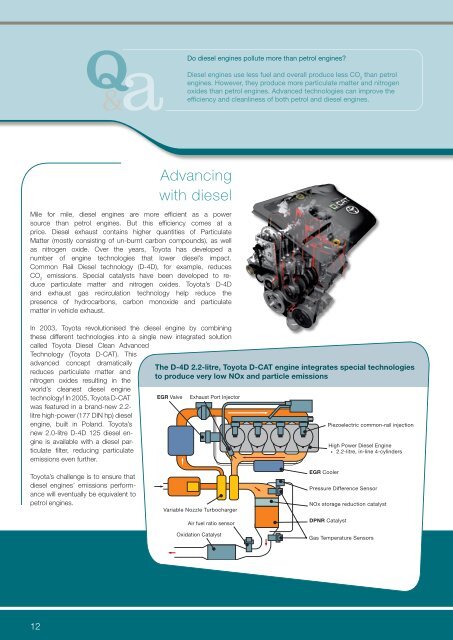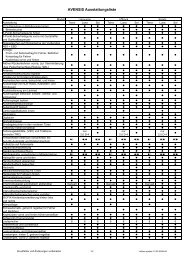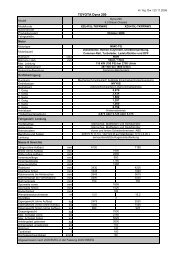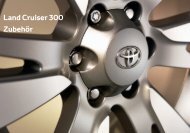Create successful ePaper yourself
Turn your PDF publications into a flip-book with our unique Google optimized e-Paper software.
Do diesel engines pollute more than petrol engines?<br />
Diesel engines use less fuel and overall produce less CO 2 than petrol<br />
engines. However, they produce more particulate matter and nitrogen<br />
oxides than petrol engines. Advanced technologies can improve the<br />
efficiency and cleanliness of both petrol and diesel engines.<br />
Advancing<br />
with diesel<br />
Mile for mile, diesel engines are more efficient as a power<br />
source than petrol engines. But this efficiency comes at a<br />
price. Diesel exhaust contains higher quantities of Particulate<br />
Matter (mostly consisting of un-burnt carbon compounds), as well<br />
as nitrogen oxide. Over the years, <strong>Toyota</strong> has developed a<br />
number of engine technologies that lower diesel’s impact.<br />
Common Rail Diesel technology (D- D), for example, reduces<br />
CO 2 <strong>emissions</strong>. Special catalysts have been developed to reduce<br />
particulate matter and nitrogen oxides. <strong>Toyota</strong>’s D- D<br />
and exhaust gas recirculation technology help reduce the<br />
presence of hydrocarbons, carbon monoxide and particulate<br />
matter in vehicle exhaust.<br />
In 200 , <strong>Toyota</strong> revolutionised the diesel engine by combining<br />
these different technologies into a single new integrated solution<br />
called <strong>Toyota</strong> Diesel Clean Advanced<br />
Technology (<strong>Toyota</strong> D-CAT). This<br />
advanced concept dramatically<br />
reduces particulate matter and<br />
nitrogen oxides resulting in the<br />
world’s cleanest diesel engine<br />
technology! In 200 , <strong>Toyota</strong> D-CAT<br />
was featured in a brand-new 2.2litre<br />
high-power (1 DIN hp) diesel<br />
engine, built in Poland. <strong>Toyota</strong>’s<br />
new 2.0-litre D- D 12 diesel engine<br />
is available with a diesel particulate<br />
filter, reducing particulate<br />
<strong>emissions</strong> even further.<br />
<strong>Toyota</strong>’s challenge is to ensure that<br />
diesel engines’ <strong>emissions</strong> performance<br />
will eventually be equivalent to<br />
petrol engines.<br />
12<br />
&<br />
The D-4D 2.2-litre, <strong>Toyota</strong> D-CAT engine integrates special technologies<br />
to produce very low NOx and particle <strong>emissions</strong><br />
EGR Valve<br />
Exhaust Port Injector<br />
Variable Nozzle Turbocharger<br />
Air fuel ratio sensor<br />
Oxidation Catalyst<br />
EGR Cooler<br />
Piezoelectric common-rail injection<br />
DPNR Catalyst<br />
High Power Diesel Engine<br />
• 2.2-litre, in-line 4-cylinders<br />
Pressure Difference Sensor<br />
NOx storage reduction catalyst<br />
Gas Temperature Sensors
















